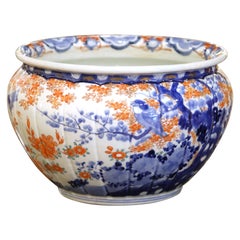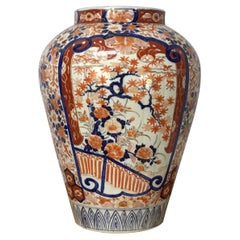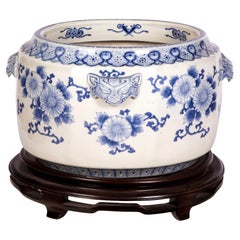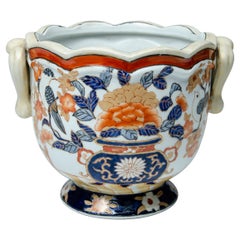Imari Porcelain Planters, Cachepots and Jardinières
to
1
1
1
1
1
1
1
1
Height
to
1
1
1
16
44
39
29
28
Creator: Imari Porcelain
19th Century Japanese Imari Porcelain Jardinière Planter with Floral Decor
By Imari Porcelain
Located in Dallas, TX
This striking bulbous jardinière is a fine example of traditional Japanese Imari ware, likely dating to the late 19th century (Meiji period, circa 1880–1910). Crafted in porcelain, t...
Category
Late 19th Century Japanese Antique Imari Porcelain Planters, Cachepots and Jardinières
Materials
Porcelain
Related Items
Large 19th Century Japanese Imari Ware Porcelain Vase
Located in Bradenton, FL
A large scale and very good quality late 19th century Japanese Imari vase with exotic birds, trees and flowers. Wonderful coloring in vibrant hues of blue, red and rust.
Category
19th Century Japanese Japonisme Antique Imari Porcelain Planters, Cachepots and Jardinières
Materials
Porcelain
Large, Japanese, Blue and White Imari Jardiniere, 19th Century
Located in Toronto, CA
A large and beautiful Japanese Imari jardiniere from the Meiji period, 19th century. Gorgeous blue and white floral decoration with four mask handles. This jardiniere comes with an e...
Category
19th Century Japanese Other Antique Imari Porcelain Planters, Cachepots and Jardinières
Materials
Ceramic
Antique Japanese Porcelain Meji Period Imari Vases Arita, Japan, 19th Century
Located in Amsterdam, Noord Holland
Sharing this lovely Japanese Imari bowl from the Meiji period. The intricate floral designs on the exterior, including the graceful chrysanthemums, symbolize longevity, resilience, a...
Category
19th Century Japanese Meiji Antique Imari Porcelain Planters, Cachepots and Jardinières
Materials
Porcelain
Pair of 19th Century Meiji Period Japanese Imari Porcelain Vases
By Imari Porcelain
Located in Pearland, TX
A gorgeous pair of antique 19th-Century Japanese Imari vases made in the Meiji period, circa 1870. These fine vases have a lovely lobed shape and hand painted floral design in the tr...
Category
Mid-19th Century Japanese Meiji Antique Imari Porcelain Planters, Cachepots and Jardinières
Materials
Porcelain
Antique Meji Period Imari Japanese Porcelain Vases Arita, 19th Century
Located in Amsterdam, Noord Holland
Sharing with you this lovely Japanese Imari bowl from the Meiji period. The intricate floral designs on the exterior, including the graceful chrysanthemums, symbolize longevity, resi...
Category
19th Century Japanese Meiji Antique Imari Porcelain Planters, Cachepots and Jardinières
Materials
Porcelain
Antique 19th Century Japanese Imari Porcelain Vase
By Imari Porcelain
Located in Pearland, TX
19th-Century Japanese Imari porcelain vase. This fine vase have a lovely shape and hand painted floral designs in the traditional Imari colors.
Category
19th Century Japanese Japonisme Antique Imari Porcelain Planters, Cachepots and Jardinières
Materials
Porcelain
Pair of 19th Century Japanese Meiji Period Imari Porcelain Vases
By Imari Porcelain
Located in Pearland, TX
A gorgeous pair of 19th-Century Japanese Meiji Period Imari porcelain vases. These fine vases have a lovely shape and hand painted floral designs in the traditional Imari colors. The...
Category
Late 19th Century Japanese Antique Imari Porcelain Planters, Cachepots and Jardinières
Materials
Porcelain
$1,495 Sale Price / set
21% Off
H 10.25 in W 6 in D 6 in
19th Century Japanese Imari Vases with Raised Dragon
Located in WEST PALM BEACH, FL
This is a very unique pair of Japanese Imari vases hand painted in typical colors of cobalt and bittersweet with bold dragons in relief un...
Category
Late 19th Century Japanese Other Antique Imari Porcelain Planters, Cachepots and Jardinières
Materials
Porcelain
Late 19th Century Porcelain Chinese Imari Famille Rose Vase
By Imari Porcelain
Located in Banner Elk, NC
Large late 19th century Chinese Export Porcelain Imari and Famille Rose hand painted vase. Extremely rare coloration.
Category
Late 19th Century Japanese Antique Imari Porcelain Planters, Cachepots and Jardinières
Materials
Porcelain
19th Century Meiji Period Japanese Imari Ribbed Blue & White Porcelain Vase
By Imari Porcelain
Located in Pearland, TX
A gorgeous antique 19th-Century Japanese Imari scalloped floral vase made during the Meiji period. This fine vase has a lovely baluster form with a ribbed design, ruffled rim, and ha...
Category
19th Century Japanese Antique Imari Porcelain Planters, Cachepots and Jardinières
Materials
Porcelain
$995
H 14.75 in W 6 in D 6 in
Pair 19th Century Japanese Imari Porcelain & Gilt-Bronze Torchere Candelabra
By Imari Porcelain
Located in Los Angeles, CA
A fine Pair of 19th century Japanese Imari Porcelain and French Gilt-Bronze Mounted Thirteen-Light Celadon Torchere Candelabra. The bottle-shaped Japonisme vases with a Royal red background, decorated with parcel-gilt and black soaring eagles in the hunt within a forestall scene. Each Vase fitted and surmounted with a French 19th century Louis XV Style 13-Light scrolled candelabrum and all raised on a circular pierced gilt-bronze plinth. circa: 1880.
Imari Porcelain (????) is the name for Japanese porcelain wares made in the town of Arita, in the former Hizen Province, northwestern Kyushu. They were exported to Europe extensively from the port of Imari, Saga, between the second half of the 17th century and the first half of the 18th century. The Japanese as well as Europeans called them Imari. In Japanese, these porcelains are also known as Arita-yaki (???). Imari or Arita porcelain has been continously produced up through the present day.
Characteristics
Though there are many types of Imari, Westerners' conception of Imari in the popular sense is associated only with a type of Imari produced and exported in large quantity in mid-17th century. This type is called Kinrande. Kinrande Imari is colored porcelain with cobalt blue underglaze and red and gold overglaze. The color combination was not seen in China at that time. Traditional Ming dynasty color porcelain used dominantly red and green, probably due to scarcity of gold in China, whereas gold was abundant in Japan in those days. The subject matter of Imari is diverse, ranging from foliage and flowers to people, scenery and abstractions. Some Imari design structures such as kraak style were adopted from China, but most designs were uniquely Japanese owing to the rich Japanese tradition of paintings and costume design. The porcelain has a gritty texture on the bases, where it is not covered by glaze. There is also blue and white Imari. Kakiemon style Imari is another type of Imari, but it tends to be categorized separately in Europe.
History
"Imari" was simply the trans-shipment port for Arita wares. It was the kilns at Arita which formed the heart of the Japanese porcelain industry.
Arita's kilns were set up in the 17th century, when kaolin was discovered in 1616 by the immigrant Korean potter, Yi Sam-pyeong (1579–1655). (He may also be known by the name, "Kanage Sambei".) Yi Sam-Pyeong, along with his extended family of 180 persons, left Korea on the offer of a privileged position in Japan. This decision was made after the occurrence of certain Japanese invasions of Korea. After Yi Sam-Pyeong's discovery, his kilns began to produce revised Korean-style blue and white porcelains, known as "Shoki-Imari".
In the mid-17th century there were also a lot of Chinese refugees in Northern Kyushu due to the turmoil on Chinese continent, and it is said one of them brought coloring technique to Arita. Thus Shoki-Imari developed into Ko-KutaniImari. Ko-Kutani was produced around 1650 for both export and domestic market. Blue and white porcelain continued to be produced and they are called Ai-Kutani. Ko-Kutani Imari for the export market usually adopted Chinese design structure such as kraak style, whereas Ai-Kutani for the domestic market were highly unique in design and are accordingly valued very much among collectors.
Ko-Kutani style evolved into Kakiemon style Imari, which was produced for about 50 years around 1700. Imari achieved its technical and aesthetic peak in Kakiemon style, and it dominated European market. Blue and white Kakiemon is called Ai-Kakiemon. Kakiemon style transformed into Kinrande in the 18th century. Kinrande used blue underglaze and red and gold overglaze, and later some other colors.
Imari began to be exported to Europe because the Chinese kilns at Ching-te-Chen were damaged in the political chaos and the new Qing dynasty government stopped trade in 1656–1684. Exports to Europe were made through the Dutch East India Company, but the designation "Imari Porcelain" in Europe connotes Arita wares of mostly Kinrande Imari.
Export of Imari to Europe stopped in mid-18th century when China began export to Europe again, since Imari was not able to compete against China due to high labor cost. By that time, however, both Imari and Kakiemon style were already so popular among Europeans, Chinese export porcelain copied both Imari and Kakiemon style, which is called Chinese Imari. At the same time, European kilns, such as Meisen also tried to copy Imari and Kakiemon.
Export of Imari surged again in late 19th century (Meiji era) when Japonism flourished in Europe. Thus in western world today, two kinds of Imari can...
Category
19th Century Japanese Japonisme Antique Imari Porcelain Planters, Cachepots and Jardinières
Materials
Bronze, Ormolu
$24,850 Sale Price / set
49% Off
H 72.25 in Dm 24.25 in
19th Century Japanese Imari Planter
Located in Tampa, FL
A very high quality late 19th century Japanese Imari planter with beautiful gold accents.. Has a hole in the center for draining. Circa 1890s.
Category
1890s Japanese Antique Imari Porcelain Planters, Cachepots and Jardinières
Materials
Porcelain
Previously Available Items
Japanese Cachapot Imari
By Imari Porcelain
Located in Buenos Aires, Argentina
Japanese Cachapot Imari
Imari design circa 1900
in perfect condition
ceramic material.
Category
Early 1900s Asian Anglo-Japanese Antique Imari Porcelain Planters, Cachepots and Jardinières
Materials
Ceramic
Imari Porcelain planters, cachepots and jardinières for sale on 1stDibs.
Imari Porcelain planters, cachepots and jardinières are available for sale on 1stDibs.



